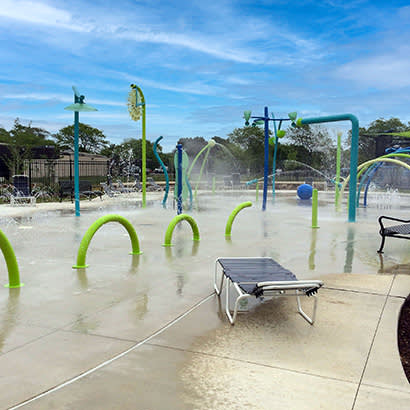
For an enhanced digital experience, read this story in the ezine.
The advantages of converting kiddie pools to splash pads
Kiddie pools in public parks were popular a few decades ago and were installed for toddlers who were too small to swim in larger pools. They had less than one foot of water and a low wall for parents to sit on the edge, and children could safely and easily enter and exit the pool.
With the rise of new aquatics trends, these areas with little playability have become unused zones in many parks. And as these spaces continue to be underutilized, park and recreation agencies are looking for better ways to bring new interest and new patrons to aquatics play areas. As a result, converting kiddie pools to splash pads has become a popular renovation option.
Creating Inclusivity
Manufacturers and designers are seeing a trend in all playgrounds — whether dry or aquatics — to design areas that include all community members, regardless of their age or abilities. Splash pads welcome users with a wide range of developmental, cognitive and physical abilities, as well as different age groups — including older generations acting as caregivers to children.
To be fully inclusive, splash pads need to have sections that attract and encourage a wide range of patrons. Using a variety of water features, water flows, spacing, sizes and colors can make the facility even more accessible to its users. The inclusive-play trend coupled with the needs of a community together dictate specific requirements within a splash pad.
Generating Revenue
Ultimately, the more people a park attracts, the more likely it will be to break even on expenses. Since splash pads attract a larger portion of the population compared to kiddie pools, the parks they live within tend to see more patrons — from babies and toddlers to tweens and grandparents, and especially those with disabilities.
A lot of facilities are not only removing their kiddie pools, but they are also increasing the footprint of their play area and adding much larger splash pads. If a facility can add a splash pad area of around 2,000 square feet, they can then fence it and open the area even before it is time for the larger pool to open. This is a huge benefit, as it extends the season for the facility and does not limit its operation based on the availability of lifeguards.
Offering Versatility
As with any community gathering space, creating a visually striking splash pad can provide excitement and interest for all users. Oftentimes, using a large, iconic water feature piece within the splash pad is important. Large buckets of water to anchor the splash pad add an element of attraction, even when the facility is not in use. One eye-catching option for splash pads is large rings that spray mist. These are both attractive and easily integrated into a sequencing design for inclusive play. Having water splash, cascade and bubble creates a series of soothing sounds, which invariably enhances the ambience.
Unlike kiddie pools, a lot of splash pad features are easy to replace by using the same or existing pipes and feeds. Splash pads offer a lot of versatility, as it is fairly easy to give a splash pad a quick update with a new spray feature.
Streamlining Safety and Maintenance
In terms of water treatment, most kiddie pools’ water is either recirculated or flow through. When it comes to replacing a kiddie pool with a splash pad, the maintenance is the same and the system can either remain unchanged or can be upgraded. Recirculation of water with a water treatment system is common for splash pads. Additionally, they use a much smaller amount of water, which means less of a need for chemical treatment. This reduction in chemical usage also lowers operational costs.
Splash pads are also being installed for safety reasons. Parents can feel more at ease having a smaller child play in a splash pad compared to a kiddie pool because there is no standing water.
A splash pad play area can become a gathering place for people of all abilities, ages and backgrounds to relax and connect through the joy of water. Not only does the naturally inclusive landscape offer a fun adventure for a community, but adding more features also gives patrons more immersive activities and satisfies their unique physical and cognitive needs. A simple but powerful space, an inclusive aquatics facility offers a glimpse of the larger picture of universal well-being and connectivity.
Suzanne DalMonte is the Regional Sales Representative for Water Odyssey and Owner of Products4Parks.

